Last updated: 29 August 2024
When I talked to a number of people and asked them about Subic, what I found out was quite astonishing. Many of them thought that Subic and Clark are one and the same. So just so we’re clear, Subic and Clark are two different areas. I think the confusion stems from the fact that both have “freeport zones”. Clark Freeport Zone (CFZ) is a former US air force base (Clark Air Base), while the Subic Bay Freeport Zone (SBFZ) is a former US naval base (Subic Bay Naval Base). Both have been converted to massive business and recreation centers.
UNDERSTANDING SUBIC
Subic is a town in the province of Zambales. Located along Subic Bay, the municipality is known for maritime industry and logistics and warehousing services. The Subic Bay Freeport Zone (SBFZ) covers the municipality of Subic and city of Olongapo in Zambales and the municipalities of Morong and Hermosa in Bataan. The conversion of the former U.S. Navy Base to an economic zone bolstered by the area’s commercial and industrial piers had catapulted the development of the Central Luzon region.
The tourism industry is also one of Subic’s strongest assets. The zone promotes ecotourism through guided treks and jungle survival tours. Aside from that, it boasts theme parks, diving spots (wreck diving), sailing, extreme water sports, and adventure parks. Outlet shops and duty-free shopping centers also attract tourists, especially those who like shopping and finding great deals.
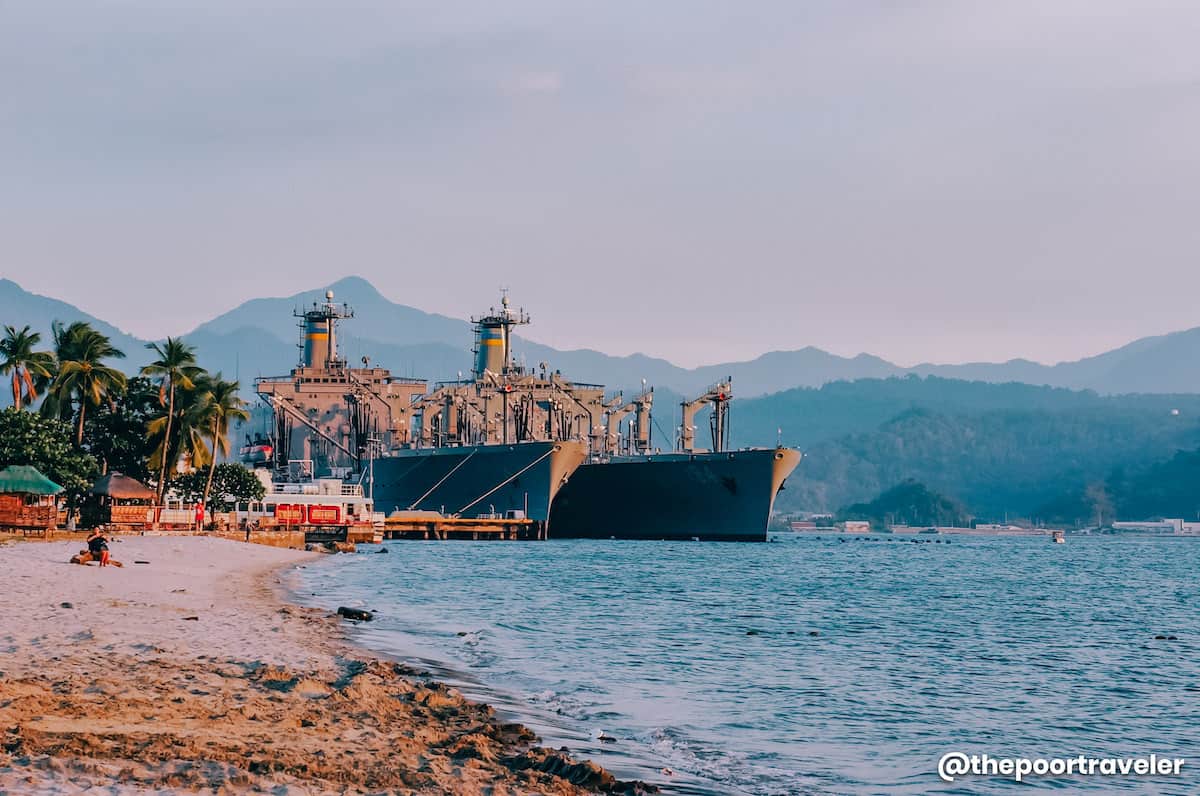
Here are more things you need to know about Subic:
- Language: The province of Zambales has three main languages — Tagalog, Ilocano, and Sambal.
- Currency: Philippine peso (PHP, ₱). PHP100 is around USD 1.78, EUR 1.60, SGD 2.31 (as of August 2024).
- Modes of Payment: CASH is preferred. Credit card payments are widely accepted, especially in business districts. If you are going outside the urban zones, ensure that you have an ample amount of cash with you.
- Connectivity: Strong data signal for both Smart and Globe, especially in urban areas.
- Electricity Info: 220V, 60Hz. Mostly, Socket Type A.
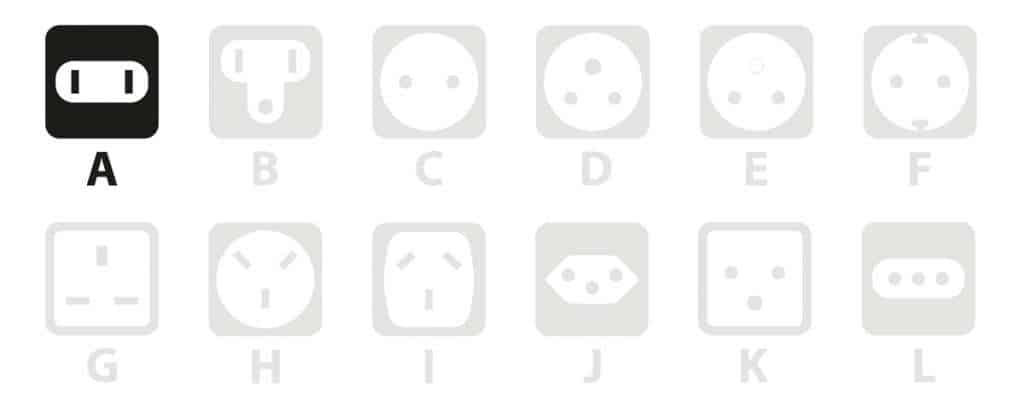
Note: This travel guide will touch the Subic Bay Freeport Zone (SBFZ), specifically the municipality of Subic and Olongapo City.
HOW TO GET TO SUBIC
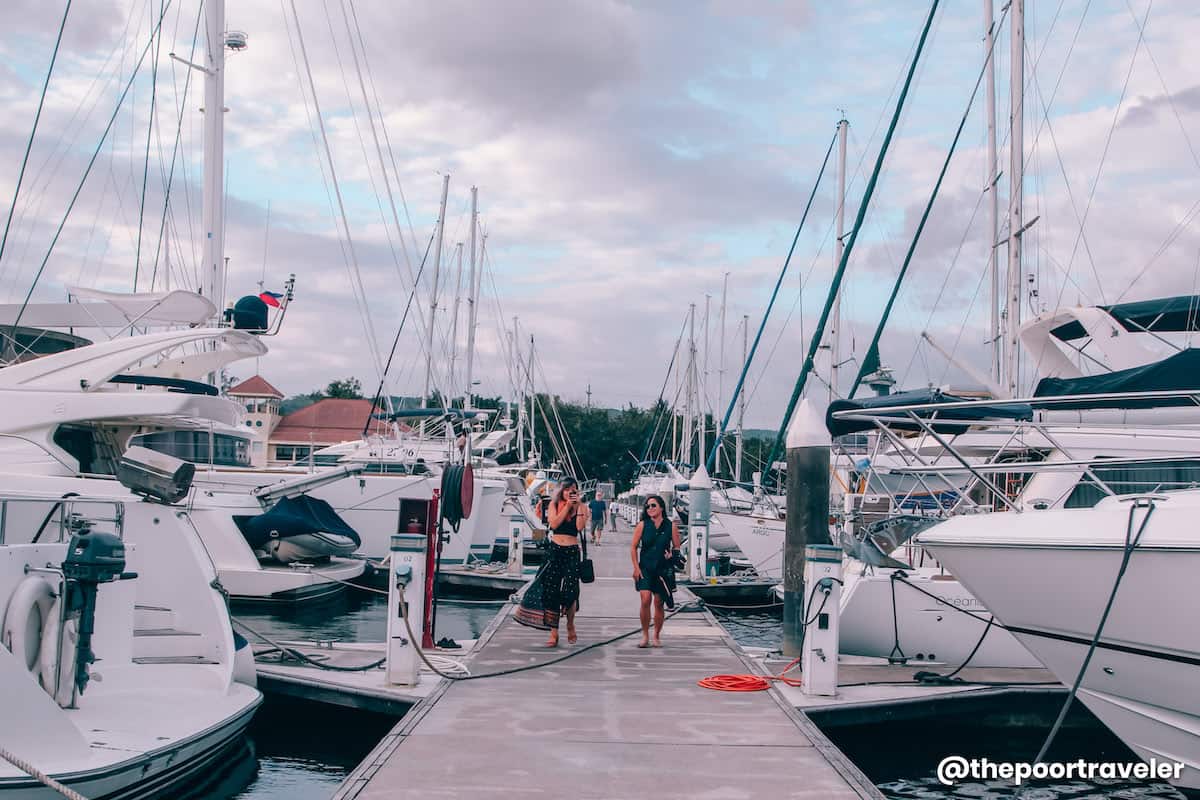
There are two gateways to Subic — the Clark International Airport and the Ninoy Aquino International Airport. The former (CIA), is the closest, located further northeast of Subic, while the latter (NAIA) is located in Manila.
Manila to Subic
By Car
Subic is usually included in the itinerary for road trips up north. North Luzon Expressway (NLEX) and Subic-Clark-Tarlac Expressway (SCTEX) connect Subic to Metro Manila. Bringing a car allows you to travel at your own pace and make a restroom break stop whenever necessary. Drive along NLEX until you reach the exit to SCTEX. Keep on driving along SCTEX, then take Tipo Exit. From there, continue driving to Subic (SBMA/SBFZ).
The travel time is two to four hours, depending on the traffic condition.
By Regular Bus
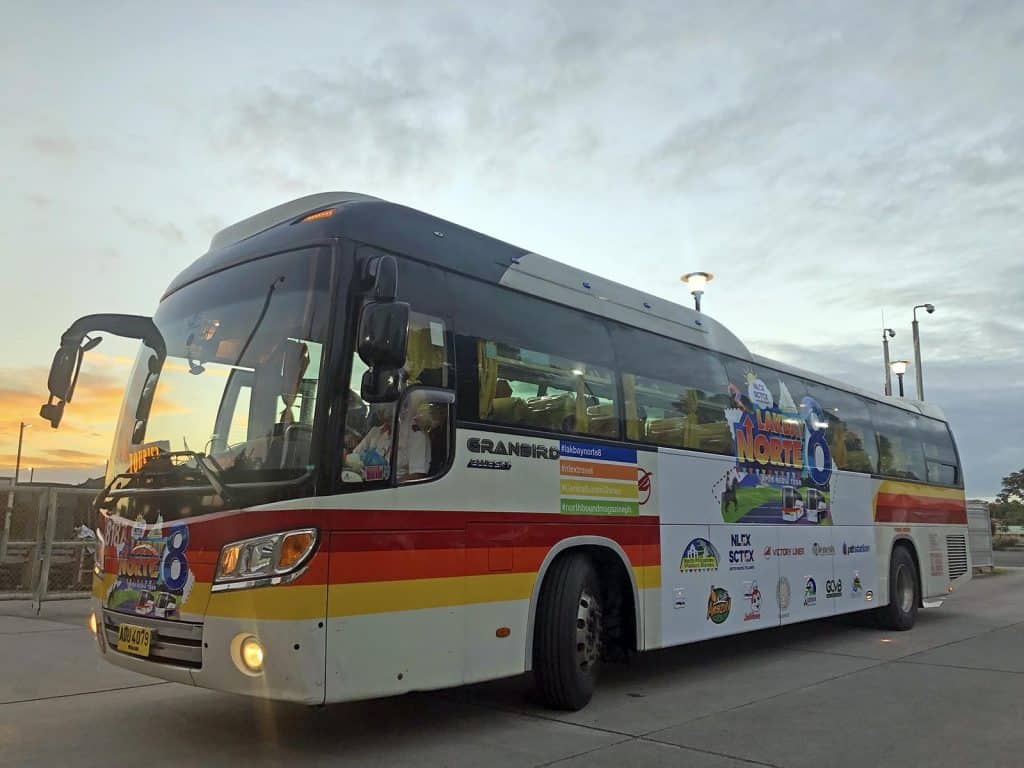
- Whether you are coming from NAIA or any point in Metro Manila, travel to Victory Liner Bus Terminal. You can go to Pasay, Sampaloc, Cubao, or Caloocan terminal. The bus company plies to Olongapo from Manila daily. Bus typically leaves every 30 minutes. The buses are air-conditioned and have wi-fi on board.
- Get on a Victory Liner bus bound for Olongapo. The fare is P230-380. The travel time is two to four hours. There’s normally a toilet break halfway.
- From Olongapo Bus Terminal, you can ride a jeepney or taxi to Subic/SBFZ. The fare varies depending on your destination and chosen mode of transportation. Jeepneys in Olongapo are color-coded per route. You can find more information about the jeepneys on the How to Get Around section below.
Notes:
- Alternatively, if you are coming from NAIA, you can take the P2P bus bound for Clark Airport. From Clark airport, you can either take the taxi to Victory Liner Dau-Mabalacat Terminal and take a bus to Olongapo Bus Terminal or you can take another P2P Bus to Subic, which terminates at Olongapo Bus Terminal.
- If you are spending the night in Subic, you can check with your hotel if they have service from Olongapo Bus Terminal or Clark.
Clark to Subic
By Car
If you are coming from Clark Airport or anywhere in Clark area, take the SCTEX and exit via Tipo Toll Exit. From, there, follow the road signs directing you to Subic (SBMA/SBFZ). The travel time is 45-60 minutes, depending on the traffic condition.
By Regular Bus
- From Clark Airport, take a jeepney to the Main Gate Entrance of the Clark Freeport Zone.
- From there, ride another jeepney to Dau-Mabalacat Bus Terminal.
- From Dau-Mabalacat Terminal, board a Victory Liner Bus bound for Olongapo.
- Get off at Olongapo Bus Terminal, then take a jeepney to Subic Town or SBFZ.
Travel time from Clark Airport to Dau Terminal is about 15 minutes. You’ll get to Subic in 60-90 minutes, depending on the bus type and the traffic condition. Total fare depends on the modes of transportation you choose.
Note: If you have light luggage with you, you can go for the jeepney. It’s a cheaper option. But if you have big and more than one piece of luggage, it’s recommended to take the taxi from the airport to Dau Bus Terminal. Or better yet, you can take the P2P bus service from Clark Airport to Olongapo.
By P2P Bus
If you are coming from Clark International Airport, you can take a Victory Liner P2P bus service to Olongapo City. The boarding platform is at Terminal 2 – Arrival Area Bus Station.
Note: The schedules may change, so it’s best to check the official website and Facebook page of Victory Liner for updates and announcements.
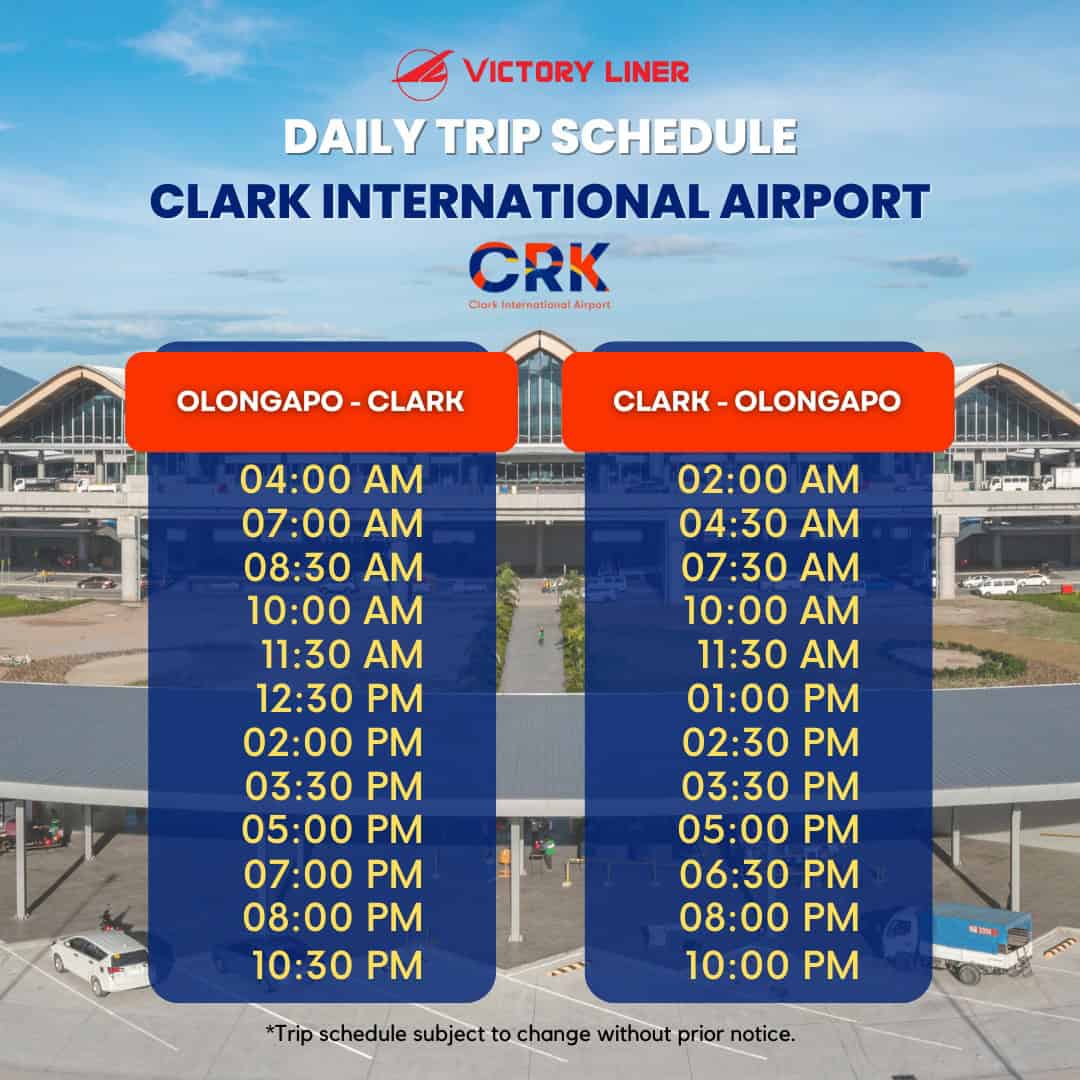
Fare: P250-260
As of: 03 January 2024
HOW TO GET AROUND SUBIC AND OLONGAPO
Jeepney
The jeepney is the primary mode of transportation for the locals, but it’s also very tourist-friendly. The jeepneys are color-coded per route. This way, it is easier to determine which jeepney one should take going to a certain destination or point.
Tourist will likely use the Yellow, Red, and Blue Jeepneys. Yellow Jeepneys shuttle along the main streets between Sta. Rita in Olongapo and the Subic Bay Freeport Zone Main Gate. Red Jeepneys cut through the side streets between Gordon Heights and the SBFZ Main Gate. This jeepney serves the bus terminal in Olongapo. Blue Jeepneys run from Olongapo city center to the municipality of Subic. This route covers the coastal areas. The fare ranges from P10 to P15.
- Yellow: Sta.Rita/Pepsi – SBFZ Main Gate
- Red: Gordon Heights – SBFZ Main Gate
- Blue: Public Market/Olongapo City Center – Subic Town
If you are curious about the other routes, you can check it here: Color Coded Jeepneys of Olongapo.
Note: If you are going to Subic Bay Freeport Zone, jeepneys are not allowed inside the premise.
Tricycle
There are a lot of tricycles in Subic town and Olongapo. “Trikes” can shuttle passengers following a particular route they chose to anchor their plate numbers to or they can function as a taxi by offering special trips, which usually works with tourists. These special trips can cover both short and long-distance route. The fare can range from P10 to P150. This includes the rate for a special trip from Olongapo Bus Terminal to Subic town.
Note: Like the jeepneys, tricycles are not allowed inside the Subic Bay Freeport Zone. They can only go as far as the main gate of SBFZ.
Taxi
Unlike the jeepneys and tricycles, taxis are allowed inside the SBFZ. Taxis operating inside the Subic Bay Freeport Zone are actually SUVs that don’t have the usual taxi sign on top of the car but have the SBFZ taxi logo and body number on the sides. Also, meter service is non-existent here. The fare ranges from P100 to P700, depending on the distance.
Outside SBFZ, you can find a significant number of taxis in the city center, especially around Olongapo Bus Terminal. You can just negotiate the fare with the driver. The fare ranges from P70 to P500.
THINGS TO DO IN AND AROUND SUBIC
El Kabayo Subic Trail
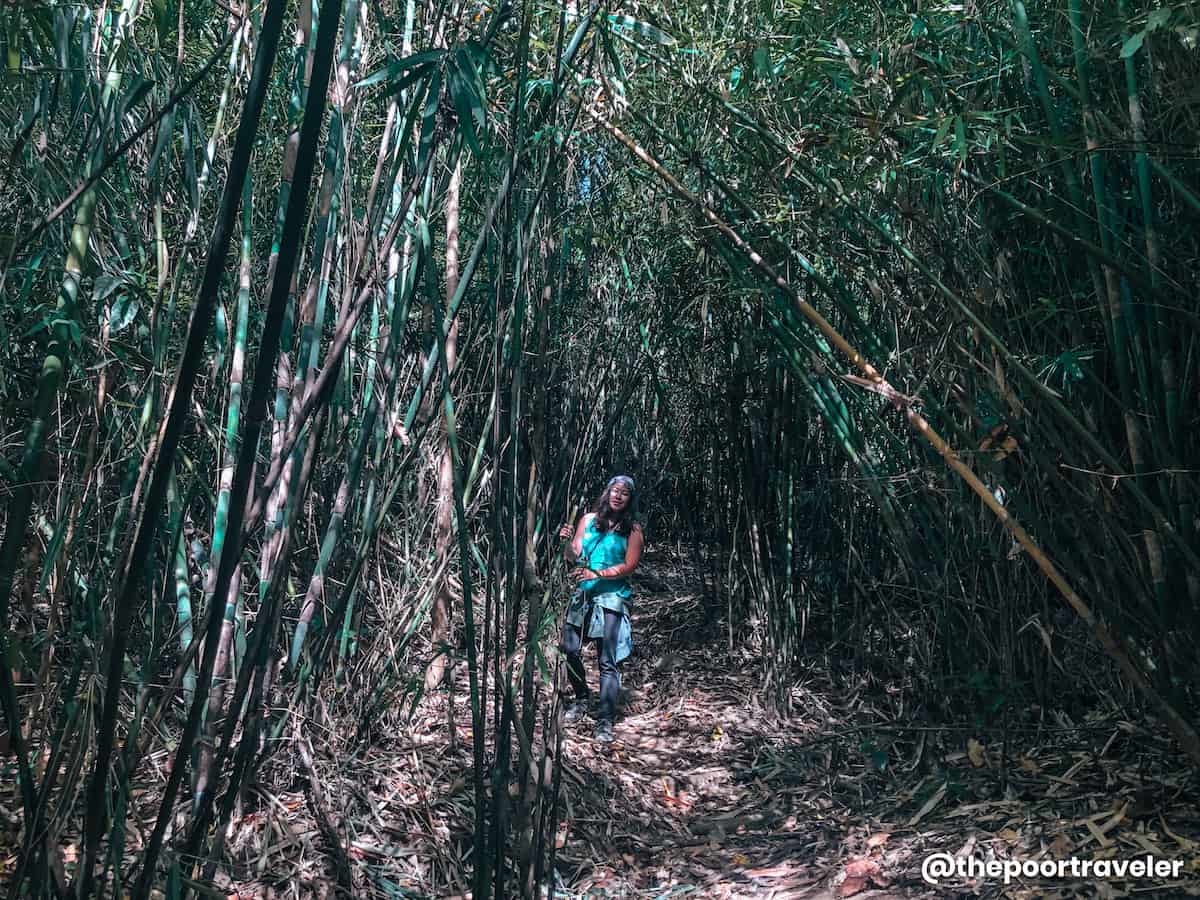
Subic is sandwiched between densely forested mountains and Subic Bay. The mountains boast rugged trails yet to be charted. Among many trekking sites is the El Kabayo Subic Trail. Under MAD Travel’s Tribe and Trek program, participants are exposed to the flora and fauna enveloping the trail while learning about jungle survival and making herbal medicine.
This activity aims to help our indigenous tribes protect and preserve their ancestral domain by educating and helping us understand the importance of our natural heritage and sustainable tourism. The El Kabayo Subic trail is home to the Aeta’s Pastolan Tribe. Check out the waterfalls too near the end of the trail.
Contact Information: info@madtravel.org / +63 939 920 7627
Official Website: www.madtravel.org
Facebook Page: MAD Travel (@makeadifferencetravel)
Location: Subic-Bataan Territory, El Kabayo Subic Trail, Subic Bay Freeport Zone
Other Similar Attractions: Pamulaklakin Forest Trails, Jungle Environmental Survival Training Camp, Apaliin Forest Trails
Subic Inflatable Island
Subic Inflatable Island is perfect for kids and kids-at-heart. Covering an area of 4,200 square meters, this is indeed a giant floating playground where you can slide, bounce, and swing to your heart’s content! It’s the ultimate bonding experience for friends and families. You’ll also find various spots to just chill, take photos, or enjoy refreshing drinks! Moreover, you’ll have access to the pool and the Tiki Hut Lounge.
Discounted Inflatable Island tickets and passes are available online. You can choose from any of these passes: Beach Club Pass, Spray Half-Day Pass, and Soaked All-Day Pass.
✅ CHECK RATES or RESERVE TICKET HERE!
Wreck Diving and Snorkeling
Subic Bay is known for its deep calm waters. It is also said to be one of the biggest naval bases of the U.S. Navy outside their motherland when it was still operational.
Beyond the lush forests and the coasts, Subic Bay is laden with several vintage shipwrecks and WWII remnants that are drawing wreck diving enthusiasts, local and international divers alike. Para sa mga mahilig sa wasakan at pilit inuungkat ang nakaraan. Haha! Some of the shipwreck sites are only around 15 minutes from the diving centers. Whether you are just starting to learn diving or already an expert, the rich marine ecosystem offers a great underwater adventure.
Some of the shipwrecks in Subic Bay are the USS New York, the USS Lanikai, the Oryoku Maru, and the Sakura Maru.
Several dive centers and operators are stationed around the Subic Bay area. Rates vary depending on the course, number of sessions, and the inclusions, but recreational wreck dive prices usually range from P2,000 to P3,000 if you have your own gear. You will have to add P1,000 to P1,200 if you’re renting gear too.
Some operators allow non-divers onto the boat and let them snorkel instead. Snorkeling fee with gear rental costs P1,500 to P1,800.
Rich Mangrove Forests
Mangroves thrive best in tropical areas. The Philippines alone cradles about half of the world’s mangrove species. Mangrove forests play an important role in maintaining the balance in our ecosystem for both land and sea. Protecting our mangrove forests means protecting our environment and our future. Subic Bay has over 60 hectares of mangrove forests scattered in six different sites including the Olongapo Bay Area, Triboa Bay Area, and Ilanin Bay Area. Source: SBMA Ecology Center.
The most popular site is the Triboa Mangrove Park. The best time to go is early in the morning or at dusk during the dry season. Take note of the tide condition too. Here are the rules and regulations when visiting the mangrove forest sites. Please follow them.
- Respect the area and be highly aware of the environment and your actions at all times. Don’t take anything with you — plants or animals. Don’t catch the crabs and other crustaceans and don’t ever step on mangrove roots and other vegetation.
- Move as little as possible and be quiet to avoid disturbing the wildlife. Do not play loud music.
- Don’t litter. Don’t smoke. If you need to use the toilet, there are restrooms available.
For inquiries, sponsorships, donations, and other concerns, please contact SBMA Ecology Center. If you want to report any violations, you may also direct your concern to their office.
SBMA Ecology Center
Address: Regulatory Building, Labitan Street corner Rizal Highway, Central Business District, Subic Bay Freeport Zone
Contact Numbers: +63 (47) 252 4059
E-mail Address: ecology@sbma.com
Facebook Page: SBMA Ecology Center (@SBMAEC)
Beaches and Resorts
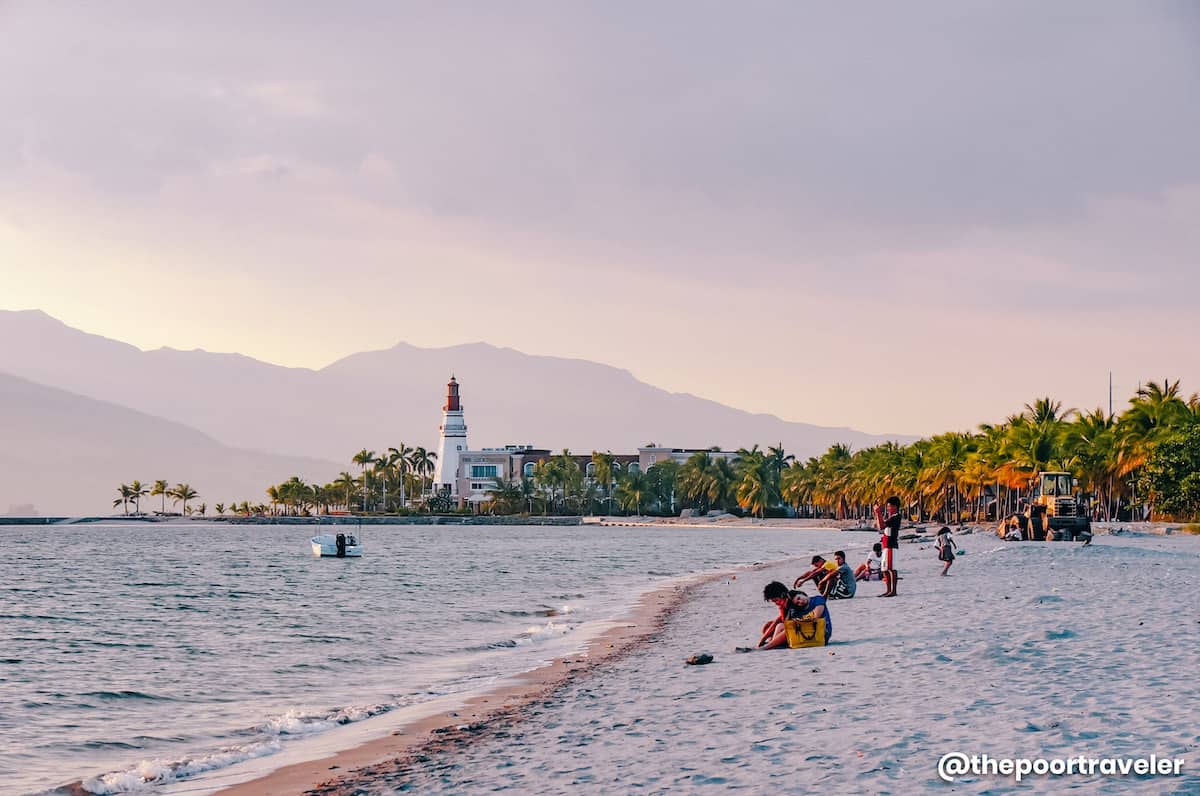
Carpeted with grayish sand hugged by gentle waves, the beach here may not be as fair as Boracay or any other beach you frequent, but it offers a perfect location to watch the sunset. The SBMA Beach boardwalk is a favorite spot among locals to watch the changing colors of sky as the sun sets.
Other beaches in the area are Baloy Beach, Sierra Beach, and Manga Beach.
Subic Shopping!
After a day of beach bumming, you can put on your bargain-hunter hat and go duty-free shopping! Aside from the beaches, you might want to take a look at the stores on your way back to Manila. Beach + retail therapy. No other formula is more effective in relieving stress.
Filipinos are known to spend money on shopping especially for souvenirs, stuff they can bring home to their loved ones. The “pasalubong culture” is strongly ingrained in most, if not all, Filipino travelers. There are plenty of shopping and dining facilities in Subic, the most popular are the outlet stores and the duty-free shops. Borrowing Subic’s tourism catchphrase, “It’s More Fun-tastic in Subic!” Agree?
Spectacular Sunsets
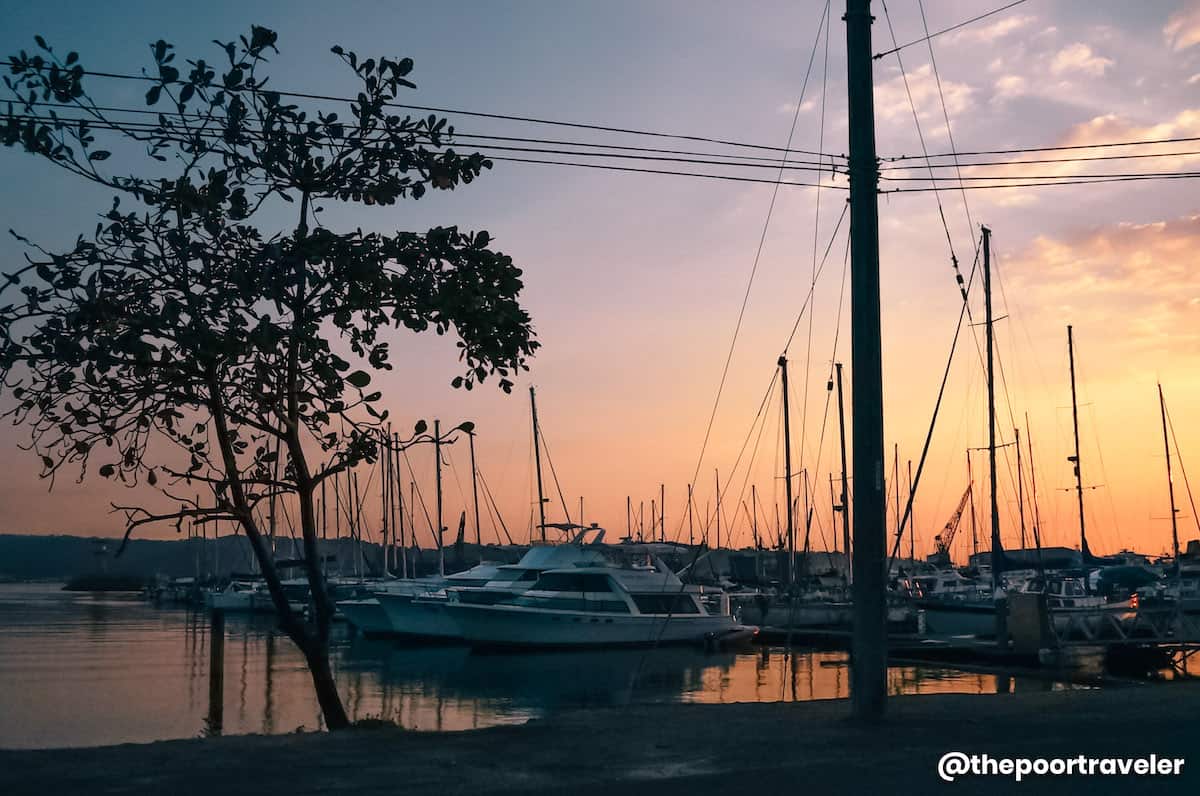
As previously mentioned, Subic Bay presents a spectacular sunset on a clear day. Aside from SBMA Beach and Boardwalk Park, there are many other great spots for sunset-watching around the Subic Bay area. These include Malawaan Park, The Lighthouse Marina Resort, and the whole stretch of Waterfront Road where you can also find the Inang Laya Monument, The Hellship (Oryoku Maru) Monument, and Children of the Sun Returning Monument. Further north, you can both enjoy the beach and the view of the sunset at Baloy Beach, Manga Beach, and Sierra Beach.
Subic Bay Yacht Cruise
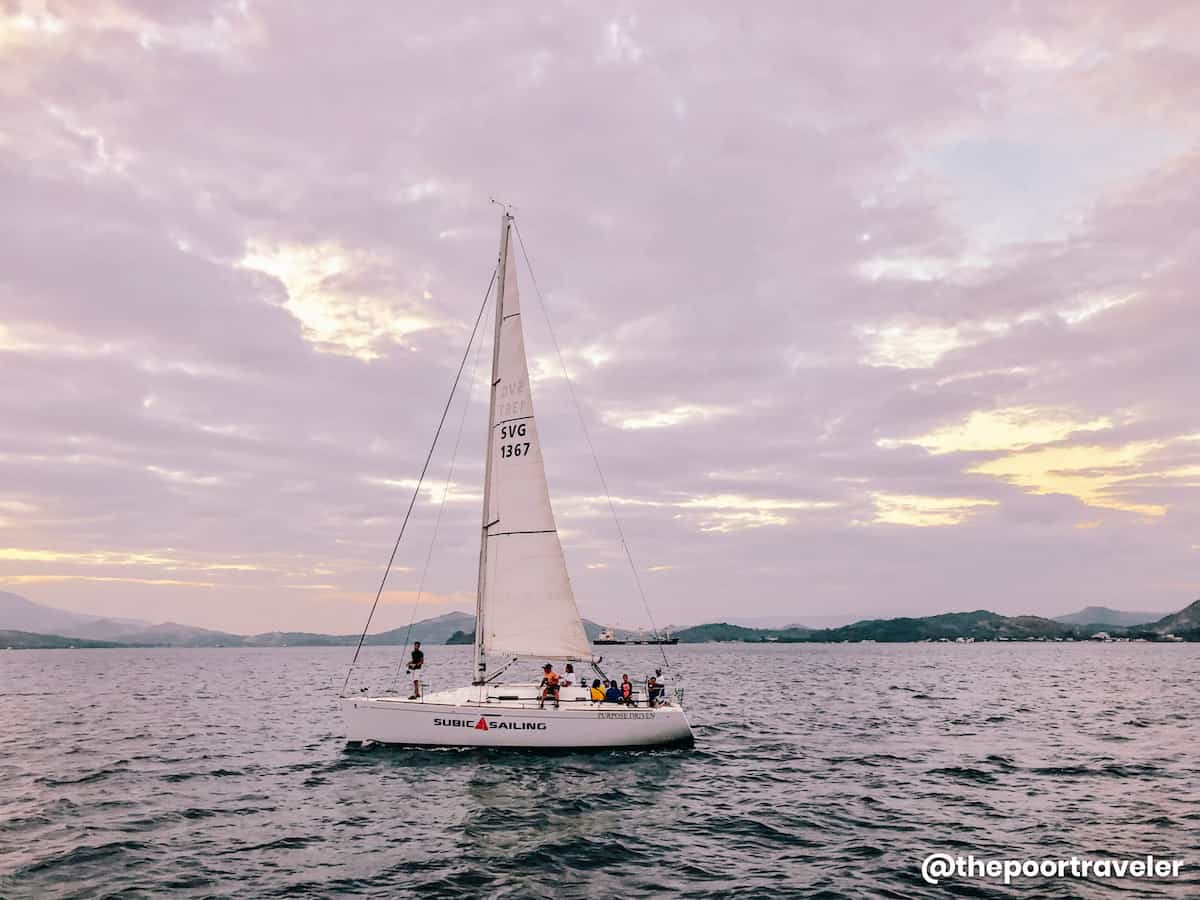
You might be wondering why we included a yacht cruise. You might be thinking it’s expensive. Well, it is. Haha. But there are ways to lower the cost. If you’re a big group, this is something to consider especially if you’re celebrating an occasion.
If you can spare over a thousand bucks for an island-hopping tour in other parts of the country, you might want to consider this too. It’s just like joining a group tour. If you’re a big group, you can scratch this off your bucket list for as low as P1,950 per person.
So, gather all your friends or your family and enjoy this unique and “nakaluwag-luwag” experience. This is also a perfect romantic getaway, especially when you do it at dusk for the beautiful sunset. If you like it, put a ring on it. Hihi.
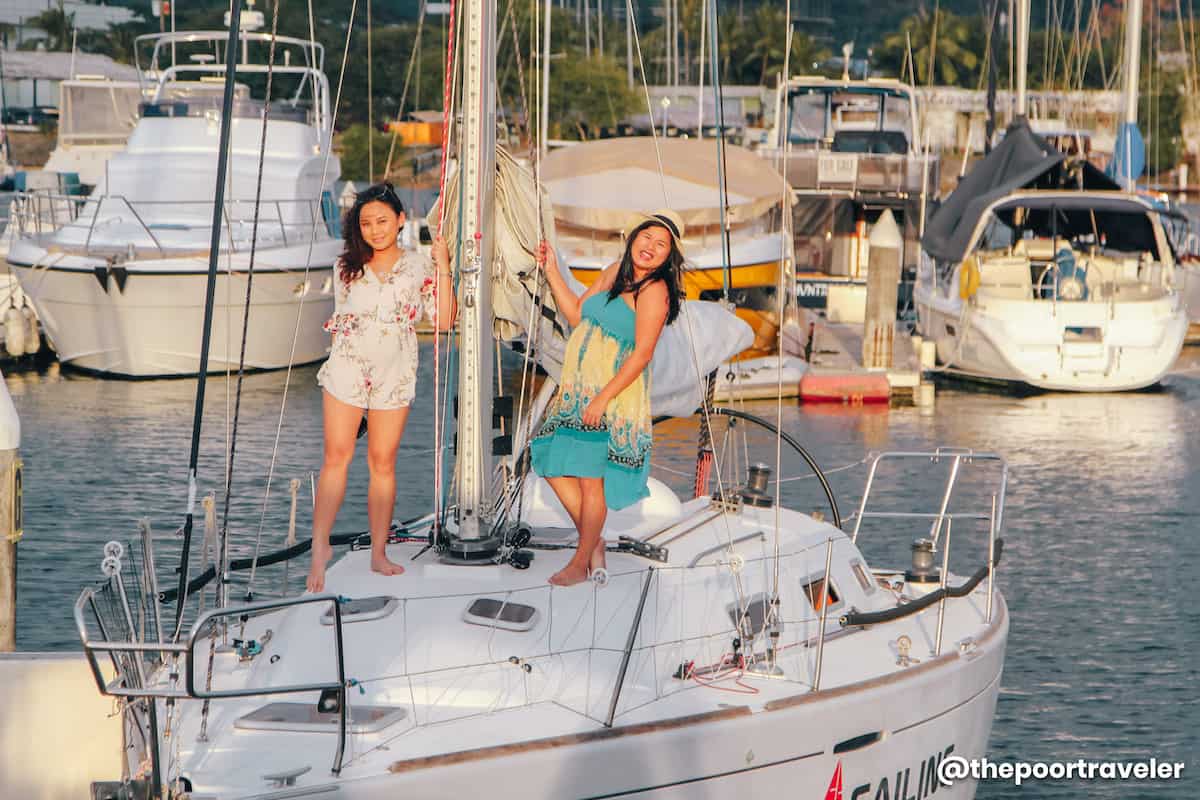
Subic Bay is gaining attention in the Asian sailing circuit. Its flat waters and the wind condition make it a challenging sailing destination. Other sports in Subic Bay are dragon boat racing, propulsion jetting, kayaking, jet skiing, and parasailing.
If you are interested, you may contact these two:
LA BANCA CRUISES
- Contact Information: +63 976 016 6765 / +63 967 360 6077 / +63 976 0133 517
- Official Website: www.labancacruises.com
- E-mail: labancacruises@gmail.com
- Facebook Page: La Banca Cruises (@LaBancaCruises)
- Location: Building 1031, Rizal Highway, Subic Bay Freeport Zone
SUBIC SAILING CLUB
- Rates: Rates depend on the type of boat you will rent, the capacity, the number of hours, and other inclusions. Subic Sailing Club offers different vessels such as yachts, speedboats, and sailboats.
- Contact Information: +63 917 536 6349 / +63 917 531 8227
- Official Website: www.subicsailing.com
- E-mail: contact@subicsailing.com
- Facebook Page: Subic Sailing Club (@subicsailing)
- Location: Subic Sailing Club, The Lighthouse Marina Resort, Central Business, Waterfront Road, Subic Bay Freeport Zone
WHERE TO STAY IN SUBIC
Being a major maritime gateway and almost a century of US Naval Base presence, Subic is one of those destinations near Manila that had an early taste of development, encouraging the establishment of different kinds of businesses such as logistics and shipping industries, restaurants, hotels, recreation and entertainment centers, shopping malls, and adventure parks.
Whatever your budget is, Subic can provide lodging that will suit your requirements and needs. If you are planning to spend the night in Subic, here are the top hotels as ranked by online users (in no particular order):
Top Mid-Range to High-End Hotels in Subic
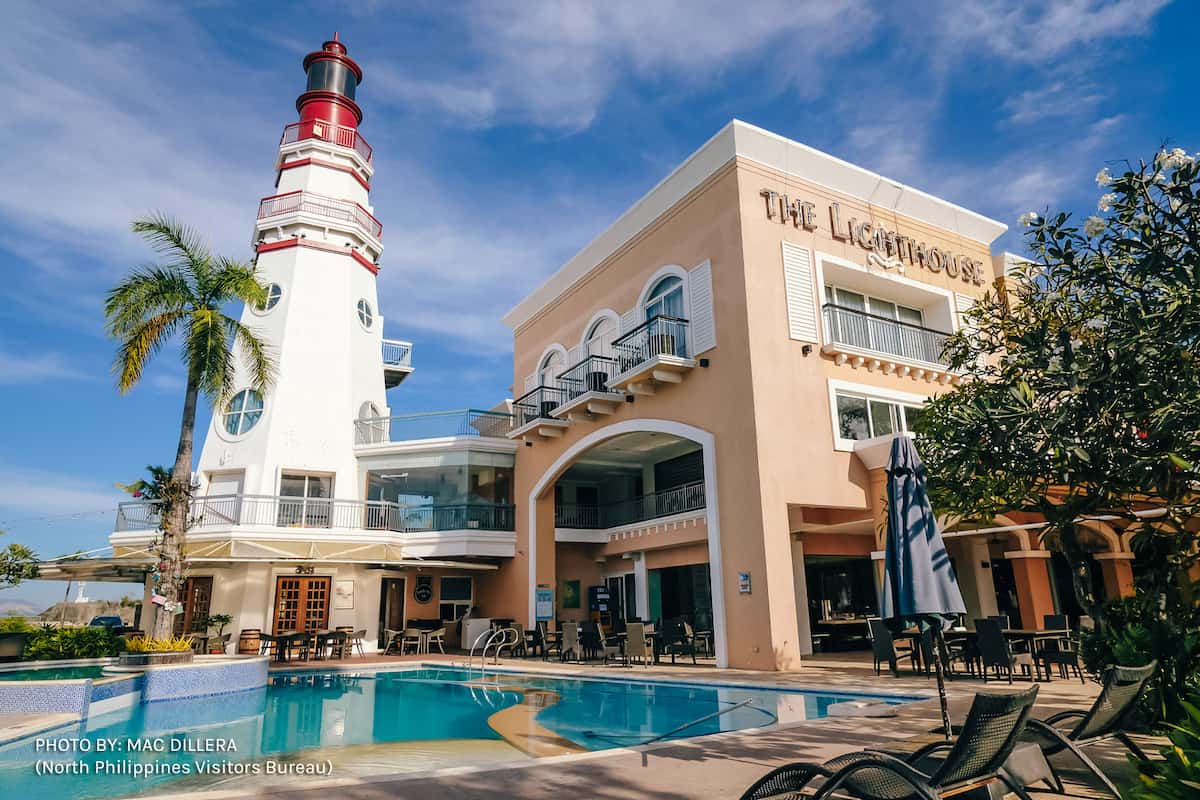
If you have the budget, consider spending your nights at an awesome hotel or resort. This will tremendously elevate your Subic experience. Subic is one of those destinations where there aren’t a lot of arresting sights or mind-blowing landscapes. Tourists come here mostly to relax and unwind. If this is also why you’re traveling to Subic, where you stay can spell the difference between typical and unforgettable.
- Le Charme Suites Subic. Check Rates & Availability!
- The Lighthouse Marina Resort. Check Rates & Availability!
- Emerald Manor Hotel. Check Rates & Availability!
- The Aurora Subic Hotel. Check Rates & Availability!
- Subic Bay Yacht Club. Check Rates & Availability!
- Kamana Sanctuary Resort and Spa. Check Rates & Availability!
- Camayan Beach Resort Hotel. Check Rates & Availability!
Top Subic Budget Hotels Below P2500
If budget is a concern, here are some properties that are still great according to online reviews but more pocket-friendly.
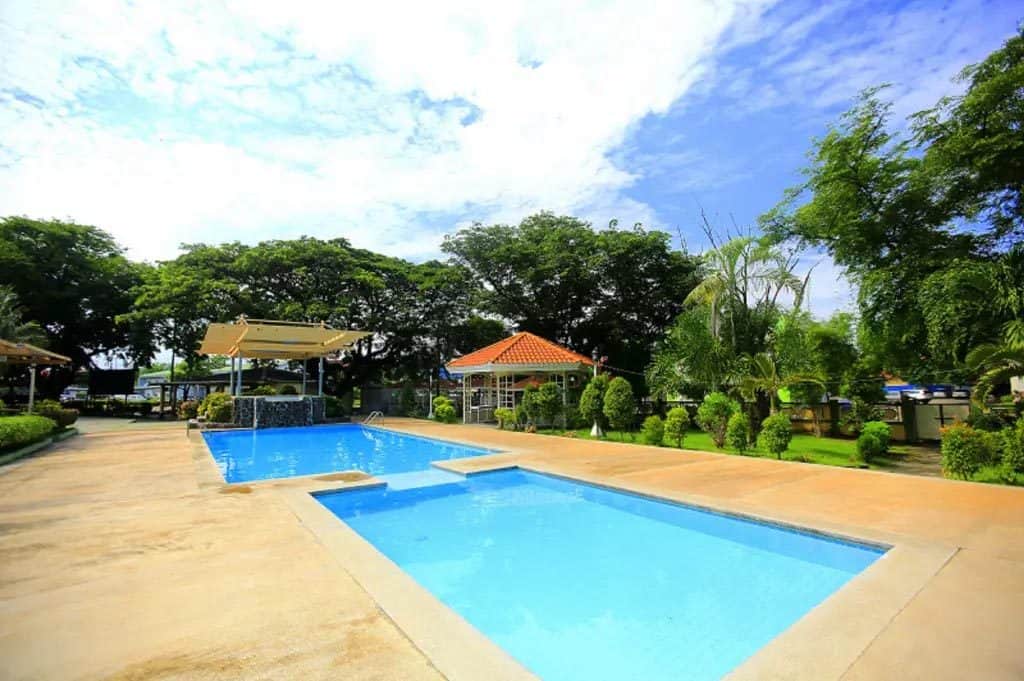
- Subic Bay Peninsular Hotel. Check Rates & Availability!
- Mango Valley Hotel 1. Check Rates & Availability!
- Subic Coco Hotel. Check Rates & Availability!
- Subic Park Hotel. Check Rates & Availability!
- Subic Bay View Diamond Hotel. Check Rates & Availability!
Search for more Subic Hotels!
SAMPLE SUBIC ITINERARY
Here are two sample one-day itinerary options for Subic. You may tweak this depending on your budget and the number of days you want to spend exploring Subic.
This assumes that:
- You are coming from Manila.
- You are a party of two and splitting the expenses.
- Your meal allowance per meal/person is P150.
OPTION 1: FOREST TRAIL
08:30 am – Arrival in Olongapo (P230-380, Bus)
08:35 am – Travel to Pamulaklakin Forest Trail inside SBFZ (P200/2)
09:00 am – Pamulaklakin Ecology Tour (P250/pax)
11:30 am – End of Trek
12:00 pm – Lunch (P150/pax)
01:00 pm – Shopping
04:00 pm – See the monuments along Waterfront Road
05:00 pm – Sunset-watching along Waterfront Road
05:30 pm – Leave for Manila (P230-380, Bus)
The itinerary above will set you back around PHP 1,500 (USD 27, SGD 35, EUR 24), excluding accommodations but including a little bit of allowance for any miscellaneous expenses along the way. If you have extra money to spend and you don’t want to worry about transfers within SBFZ, local guide, jungle survival training, and lunch for the trekking activity, you might want to consider MAD Travel’s El Kabayo Trail Tour Package.
OPTION 2: BEACH
08:30 am – Arrival in Olongapo (P230-380, Bus)
08:35 am – Travel to Olongapo Beaches (P30-150/2)
09:00 am – Barretto, Baloy, Manga, or Sierra Beach
09:30 am – Swim and Relax
12:00 pm – Lunch (P150/pax)
02:00 pm – Freshen up
03:00 pm – Travel to SBFZ (P30-150/2)
04:00 pm – See the monuments along Waterfront Road
05:00 pm – Sunset-watching along Waterfront Road
05:30 pm – Leave for Manila (P230-380, Bus)
The itinerary above will cost you around PHP 1,300 (USD 23, SGD 30, EUR 21), excluding accommodations but including a little bit of allowance for any miscellaneous expenses along the way.
OTHER SUBIC TIPS FOR THE POOR TRAVELER
- Practice the “Leave No Trace” principle. Leave nothing but footprints; kill nothing but time; take nothing but photos. Be mindful of your actions. Collect your garbage and apply proper waste disposal.
- Practice sustainable tourism. Help the local community by buying their products. Reduce waste by bringing your own water container and dry bags (or eco bags) instead of buying plastic bottled drinks and plastic bags.
FREQUENTLY ASKED QUESTIONS ABOUT SUBIC
When is the best time to visit Subic?
December – May. Most of the attractions in Subic are done outdoors, so it’s better to go there during the dry months. High summer months are April and May, but summer begins as early as March. The rainy or wet season is from July to October with the highest chance of rainfall in July, August, and September.
How can I get around Subic Bay Freeport Zone?
By taking the SUV taxis. Tricycles and Jeepneys are not allowed inside the premises, but they can drop you off until the Main Gate. From there, you can take a fixed rate SUV taxi to get around SBFZ.
How will I know the exact fare for the taxi ride inside SBFZ?
The fare ranges from P100 to P700, depending on the distance. This is actually quite tricky because these taxi don’t use meter service, and based on our team’s recent visit this year (February 2024), they also don’t provide fare matrix. So, you need to negotiate the fare. Each SUV taxi can accommodate up to seven (7) passengers.
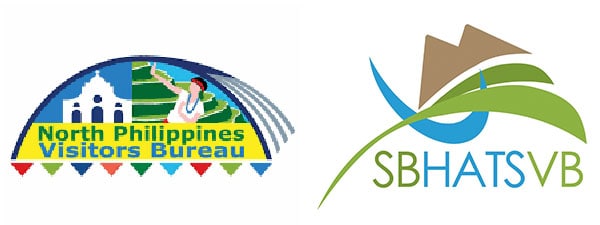
I’m grateful to the North Philippines Visitors Bureau (NPVB) and the North Luzon Expressway (NLEX) Corporation for having us again on their Lakbay Norte project. This year, we’ve covered Clark, Subic, and Baler for the Lakbay Norte 8 familiarization trip.
The North Philippines Visitors Bureau is a non-stock, non-profit membership-based umbrella organization of Convention & Visitors Bureau (CVB) all over North Philippines. The aim is to promote destinations through events & conventions.
Updates Log
2024 8 29 – Updated to reflect changes in fares, schedules, and rates
2019 3 26 – First up
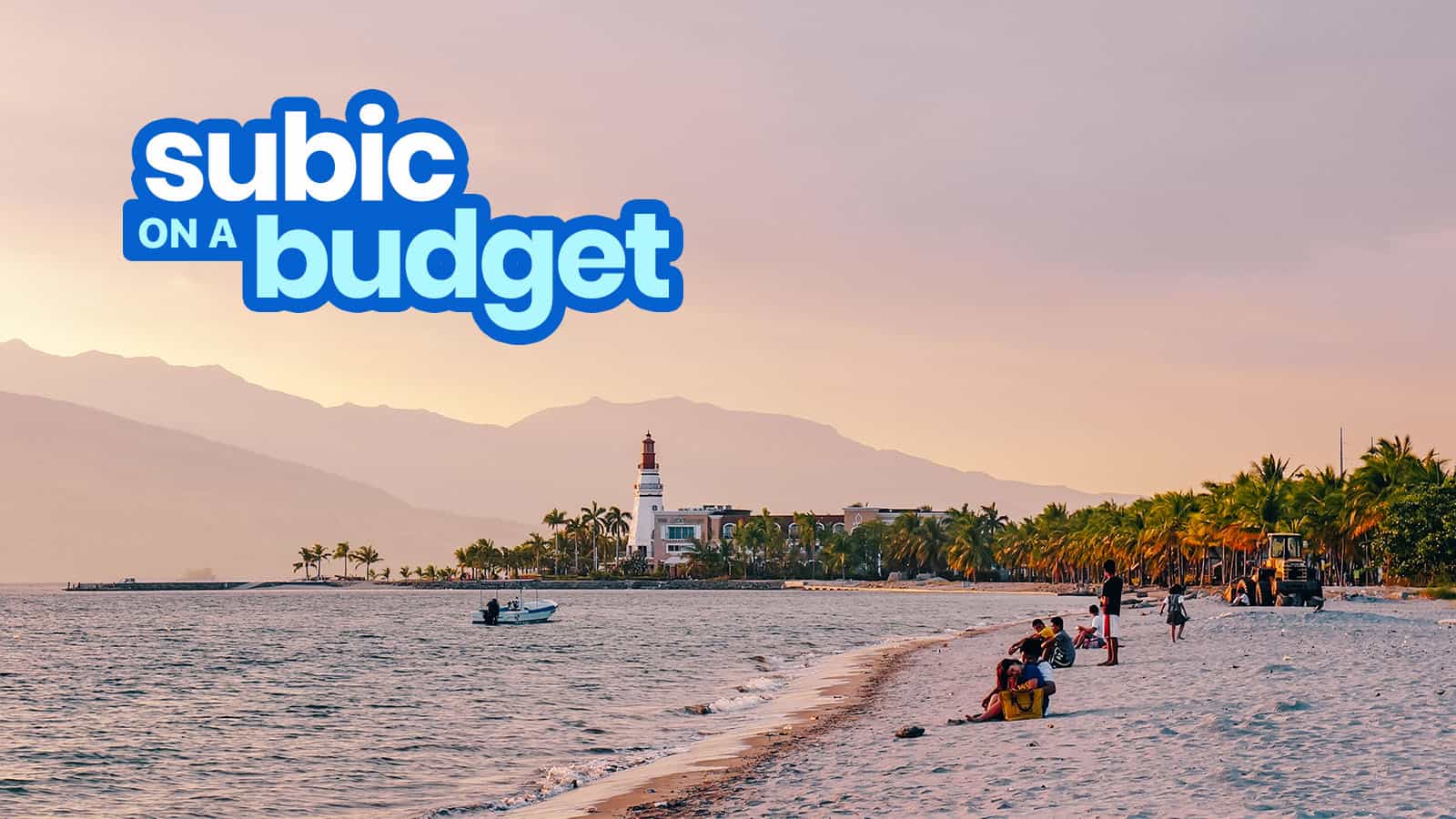

























Wow! really wonderful. It was really wonderful. It was some good tip for me .Thank you very much for the post.
Nice post thanks for sharing
Thanks.
Wow! I really liked it..
Thanks for sharing it..
Your tips are very useful to me..
Thanks!
Thanks so much for sharing! Subic is really a nice place to visit. Would love to come back there sometime when we get the chance.